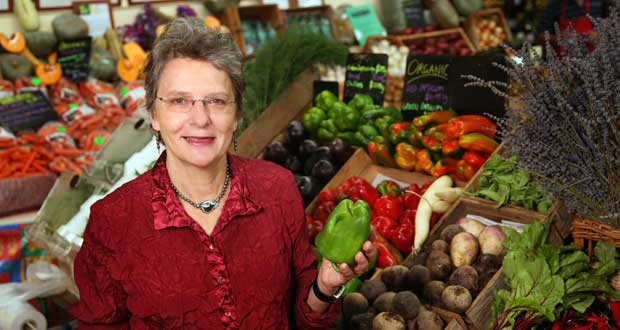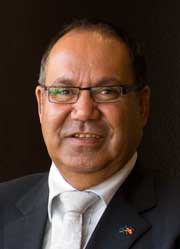02 January 2013

Sitting in the tranquillity of her office at UniSA’s Sansom Institute for Health Research, Professor Kerin O’Dea (pictured above), is animated as she talks about her work with Aboriginal Australians.
Awarded an $8 million National Health and Medical Research Council program grant which commenced in 2011 to tackle the Indigenous diabetes and cardiovascular disease epidemic, her passion to understand and improve people’s health goes back more than 30 years.
Since 1977, Prof O’Dea has been interested in the role traditional diets can play in improving our health. She says she was fascinated to learn at university that many modern day medicines came from traditional cultures. Since then she has taken a keen interest in Aboriginal health issues and the impact modern living and modern diets have had on health.
“Many of our medicines come from traditional cultures; there’s a lot of interesting knowledge there,” Prof O’Dea says.
“For example, the poison arrow (curare) from South America would paralyse muscles for a short period of time and that was how people hunted. Now that we can isolate the active ingredients we use it a lot in Western medicine.
“I became very interested in traditional lifestyles and diet as well as diabetes, and that has really driven my interest in nutrition ever since, because you can learn so much from it. Traditionally, Aboriginal people didn’t have to worry about unhealthy products, only poisonous ones.”
But the advantages of a traditional hunter-gatherer lifestyle don’t mean much for the health of most modern-day Aboriginal people who share our highly processed diets (rich in sugars and fats), and therefore the modern epidemics of obesity, diabetes and cardiovascular disease.
Prof O’Dea says diabetes is on the rise across Australia, but nowhere more markedly than in Aboriginal communities.
“Diabetes is on the rise across the board, but Aboriginal people are getting it much earlier in life, when they are still in their 20s and 30s, and at rates around 10 times higher than non-Indigenous Australians. People are getting it in their teenage years – it’s happening in wider society as well, but it’s happening more among Torres Strait Islanders in particular and some Aboriginal groups,” she says.
“The diabetes itself is not the problem, although of course it has to be well managed. The real issue is that when you get it early in life, you’re far more likely to develop complications.
“Kidney failure among Aboriginal people is another huge health issue. It is particularly serious in the very remote communities. Seventy per cent of Aboriginal people who have kidney failure have diabetes, compared to 35 per cent in the rest of society. When you’ve got diabetes you’ve got a much higher risk of heart disease, and when you’ve got kidney disease, you’ve got a much, much higher risk of heart disease. They interact and amplify each other, making it very hard to tease the interactions apart.
“The average age at which Aboriginal people die is still much lower, between 16 and 17 years lower than non-Indigenous Australians. It upsets people greatly, because they say all they do is go to funerals.”
The key to improving health outcomes for Aboriginal people is to look after the health of young women and their children, according to Prof O’Dea. She says pre-pregnancy and pregnancy care could make a significant difference to the health of babies for the rest of their lives.
“There’s a huge amount of work to be done, but I really do think that there are encouraging opportunities to make a difference, particularly early in life, and particularly looking at the food supply. If we can give people a healthy start to life, at least that gives them a chance. Encouraging breast-feeding for at least six months before a transition to healthy solids is important,” she says.
“As in other very remote areas, there are serious food problems in the APY Lands. Healthy food is significantly more expensive than it is in town. Under those circumstances, I would favour trying to provide healthy meals for children post-weaning, at pre-school age and at school. If you can give a simple, healthy breakfast and lunch, which doesn’t have to be expensive, you can really give them a very good start in life.
“You can then encourage children to take an interest in their own health. I love those innovations in Aboriginal communities with kitchen gardens. Children can learn about growing food, cultivation and agriculture and also how to prepare that food. I remember, as a child, I loved to eat things that I had grown myself. There was something exciting about it.
“There’s also a view in the field that this is probably the best way to get these messages into families, through the children rather than through the parents. You can also integrate it into the school curriculum around health. There are lots of classroom exercises such as calculating what it costs to produce the food. In many instances, this is how you engage children who haven’t been engaged before.
“I am really keen for us to reward people for buying healthy food. It would cost so much less than subsidising medicines. We need to trial such approaches and then do the cost-benefit analysis. That’s the kind of work that we need urgently.”
Prof O’Dea also points to the importance of Aboriginal role models to encourage health and aspiration in the community. She points to the Indigenous peoples of New Zealand, Canada and the United States, where many Indigenous people are leaders in the wider community.
“We’ve got an increasing number of local role models now. These are some of the good stories. The Aboriginal doctors and nurses, the teachers need to be encouraged and celebrated. That’s very, very important so people see them as role models,” she says.
Asked what motivates her work, she pauses to consider.
“You go to Aboriginal communities and the little kids are running around, excited and having a lovely time, with bright sparkling eyes and then at a certain time, it’s like a screen comes down. It’s like they don’t have hope anymore, and that’s the thing that just breaks your heart,” she says.
“You really want children to feel like they’ve got great possibilities ahead in their life – we always want that for children. That, to me, is the biggest challenge and that’s what a lot of Aboriginal leaders like Noel Pearson say too.
You’ve got to be firm to be kind in the long term. Short-termism doesn’t work. You’ve got to take the long view.”
by Rachel Broadley
As the oldest Aboriginal and Torres Strait Islander Higher Education program in Australia, UniSA’s David Unaipon College of Indigenous Education and Research (DUCIER) plays an important part in bringing Aboriginal education into the mainstream.
 As well as advising the University on all matters relating to Indigenous Australians, DUCIER offers awards in Indigenous Studies and Australian Studies from degree level through to PhD and research opportunities. DUCIER also provides academic support for Indigenous students.
As well as advising the University on all matters relating to Indigenous Australians, DUCIER offers awards in Indigenous Studies and Australian Studies from degree level through to PhD and research opportunities. DUCIER also provides academic support for Indigenous students.
In June 2011 the college was awarded $7.5 million from the Federal Government to research and implement ways of increasing the numbers of Aboriginal and Torres Strait Islander teachers in Australian schools.
The project will explore the potential for growth in teacher numbers by analysing demographics, looking at how teaching is promoted as a career, how recruitment can be enhanced and fostered, and how to encourage the retention and development of Indigenous teachers as Principals and senior education administrators.
Lead researcher for the More Aboriginal and Torres Strait Islander Teachers Project is Professor Peter Buckskin, Dean: Indigenous Scholarship, Engagement and Research, supported by Emeritus Professor Paul Hughes and Dr Kaye Price from the University of Southern Queensland.
Professor Peter Buckskin says the funding will provide an invaluable opportunity to develop a complete picture of what elements will garner and develop more Indigenous young people to become teachers and leading educators.
“We already know that while four per cent of students are Aboriginal or Torres Strait Islander, only one per cent of teachers are Indigenous,” Prof Buckskin says.
“We want to lift those numbers and get a better understanding of both the impediments and incentives that may help to increase the number of Indigenous people entering teaching.
“Our goal for the research is that it will underpin the development of many more lndigenous teachers enriching the learning experience of all Australian children, and in particular Indigenous children.”
by Rachel Broadley



